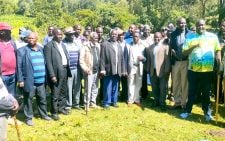Why Giraffes’ population is making a comeback

Once iconic symbols of Africa’s savannas, giraffes have experienced a quiet decline over the past few decades. Across Africa, giraffe populations declined by nearly 30 per cent over the past 35 years. However, conservationists are now cautiously optimistic about their future.
The recently published State of Giraffe 2025 report by the Giraffe Conservation Foundation (GCF) reveals encouraging news for species whom experts had termed as experiencing ‘silent extinction’: three out of the four distinct giraffe species are showing signs of population recovery.
In what experts christened some rare good news for African towering mammals, the overall number of giraffes has increased by almost 20 per cent since 2015 and now stands at just over 117,000 individuals, according to the Conservation Foundation.
Increasing population
This progress is the result of years of dedicated conservation efforts, improved monitoring, and increased global awareness. Despite ongoing threats, giraffe populations are increasing.
The southern giraffe population has grown by nearly 50 per cent over the past five years and is now estimated to be 68,837 individuals. The Masai giraffe, primarily found in Kenya and Tanzania, has stable numbers, with about 43,926 in Kenya alone.
The reticulated giraffe, which was once experiencing a sharp decline, now has an estimated population of 20,901 individuals.
However, the northern giraffe, with only 7,037 individuals remaining, is still critically endangered. Even in this group, though, a 20 per cent increase gives us reason for hope.
This positive trend, however, conceals a more complex reality. Habitat fragmentation, infrastructure development, and the rampant bushmeat trade continue to threaten giraffes across the continent.

Kenya is home to three of Africa’s giraffe species: Masai, Reticulated, and Nubian (Rothschild’s), and these challenges are particularly evident here.
The leadership in giraffe conservation in Kenya has been shaped by partnerships among the Kenya Wildlife Service (KWS), the African Fund for Endangered Wildlife (AFEW Kenya), conservationists, researchers, and local communities.
“Today serves as a platform to reflect on the milestones achieved in conserving giraffes, their habitats, and their food sources. It is also a call to deepen collaboration and innovation to prevent giraffes from edging closer to extinction,” stated KWS Board Chair Lt. Gen. (Rtd) Walter Raria Koipaton during the World Giraffe Day celebrations.
“This extraordinary biodiversity brings with it an extraordinary responsibility. We have stabilised giraffe populations across key ecosystems—over 15,000 Maasai giraffes in Amboseli and Tsavo, nearly 20,000 Reticulated giraffes in northern Kenya, and more than 1,000 Nubian giraffes through intensive protection measures.”
Facing unique crisis
Despite their towering presence and popularity among tourists, giraffes face a unique crisis: many people are unaware that their numbers have dramatically decreased in recent decades.
The bushmeat trade poses a growing threat, as a single giraffe can provide over 700 kilograms of lean meat.
Myths about the medicinal value of its bone marrow, the ease of hunting using snares or deep trenches, and its large size make the giraffe a preferred target in some regions.
“In Northern Kenya, the reticulated giraffe moves into insecure areas where illegal arms are common, and markets for bushmeat exist across borders. Those working to conserve giraffes often earn less than those exploiting them. Until that changes, giraffes will remain under threat,” describes Dickson Kaelo, CEO of the Kenya Wildlife Conservancies Association.
Community conservancies play a vital role, particularly in the remote areas of northern Kenya. However, they face limitations; many still lack legal land ownership despite the 2016 Community Land Act.
“The rangers, often young volunteers, patrol vast landscapes with minimal resources. When poachers are arrested, weak judicial systems sometimes allow them to return and intimidate the communities. Funding is also a challenge, as donors hesitate to support remote regions due to limited access and security concerns,” adds Kaelo.
Some notable conservation successes have emerged in Southern Kenya, particularly concerning the Masai giraffe. Conservancies in this region are managing landscapes for both cattle and wildlife, ensuring the restoration of migration routes, habitat connectivity, and community benefits. As a result, giraffes in these areas are not only surviving but also thriving, with local communities stepping up as guardians of the savanna.
AFEW Kenya, through the Giraffe Centre, has been a champion of giraffe conservation for decades. Since the education project began in 1984, over 3 million students have visited the centre.
AFEW Kenya emphasises the importance of collaborative conservation efforts and reaffirms its strong partnership with the Kenya Wildlife Service (KWS).
“AFEW is actively supporting the implementation of the National Recovery Action Plan for Giraffes through education, habitat restoration, community engagement, and public advocacy. Together, we are working to reverse the decline of this iconic species,” said Christine Nyang’ana, CEO of AFEW Kenya.
Evolving conservation efforts
Mr Jagi Gakunju, AFEW Board Chair outlined a five-pronged approach based on innovation: education, technology, research, policy, and socio-economic transformation.
“We must utilise GPS tracking, remote sensing, and AI surveillance to monitor giraffe populations and habitats. At the same time, we need to explore new tourism models that benefit communities,” he stated.
Their rewilding project in Baringo and ecological monitoring activities at the Giraffe Centre are examples of how conservation efforts are evolving.
Kenya’s National Giraffe Recovery and Action Plan (2023–2027) aims for net population growth of giraffes. The plan outlines key interventions, including habitat restoration, population monitoring, species rewilding, and community engagement.
Prof Erustus Kanga, KWS Director General, is advocating for the development of wildlife-sensitive infrastructure, such as corridors, underpasses, and dispersal zones, to facilitate the safe movement of giraffes between ecosystems.
He expresses deep concern about the threats posed by low-hanging power lines, road kills, and the unchecked bushmeat trade.
“We must shape a future where giraffes are safe—from policy to planning, education, and enforcement,” he stated.
Julian Fennessy of the Giraffe Conservation Foundation emphasises the urgency of the situation.
“These new data necessitate a reassessment of the giraffe’s status on the IUCN Red List. A one-size-fits-all conservation approach will not be effective; each species requires tailored strategies.”
However, the charity further warns that the giraffe population remains precariously low, particularly when compared to that of the African elephant—there is only one giraffe for every three to four elephants.
According to GCF, these findings, based on extensive ground and aerial surveys, interviews, game counts, and camera traps, have transformed the global understanding of giraffe conservation.











